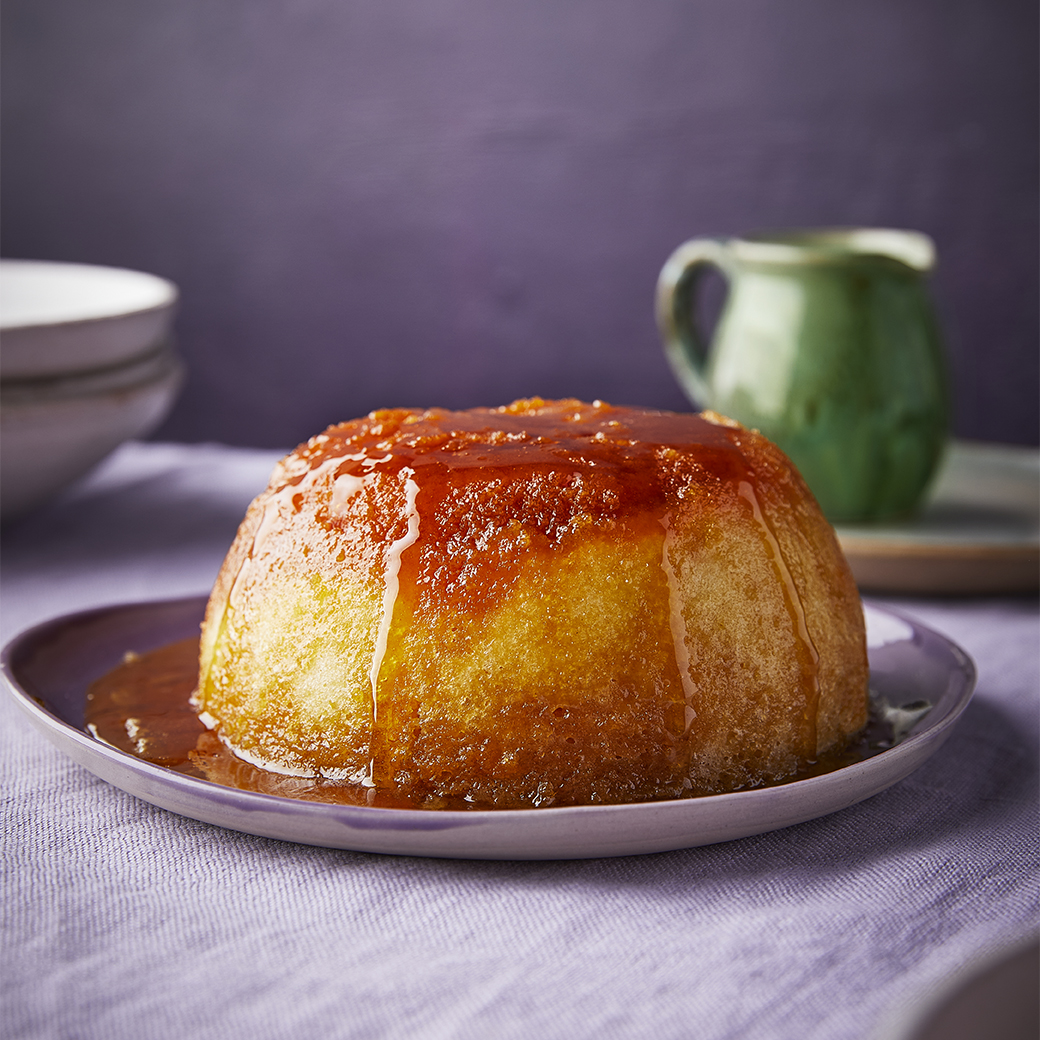- Recipes
- Nigella's Speedy Steamed Syrup Sponge

Nigella's Speedy Steamed Syrup Sponge
-
4 serving
Prep time:
Cook time:
Serves: 4
Share recipe
Ingredients
- 125g very soft unsalted butter, plus 10g for greasing the pudding bowl
- 200g golden syrup
- 125g granulated sugar
- 1 lemon, finely zested, ½ juiced (approx. 30ml)
- 125g self-raising flour
- ¼ tsp fine salt
- 2 large free-range eggs, at room temperature
- 300ml double cream, to serve
Method
Step 1
Grease a 2-pint (approx. 1.4L) plastic pudding basin and its lid (or use a similar capacity Pyrex bowl with a double layer of cling film, encasing the whole bowl) with 10g butter, then measure the golden syrup into it, and set to one side for the time being.
Step 2
If you’re making this by hand – though if you have a processor, proceed to step 4 now – measure out the remaining 125g butter into a wide-ish mixing bowl (not a huge one: these are small amounts), along with the sugar, and add the finely grated zest of the lemon. Squeeze half of the now-bald lemon into a bowl, and set aside for now, and likewise, fork the flour and salt together in a small bowl, and put that to one side, too.
Step 3
Cream the butter, sugar and zest together with a wooden spoon. Don’t be tempted to use a whisk as you don’t want to beat too much air into it. When you have a soft, pale mixture, beat in the first egg, followed by 1 tbsp or so of flour (and don’t worry that the mixture will look fairly curdled), then add your second egg, followed by 1 tbsp or so of flour and beat that until absorbed too. Now, a heaped spoonful at a time, beat in the rest of the flour and salt, and when all is incorporated into a soft batter, beat in your lemon juice.
Step 4
If you’re using a processor, add butter, sugar, lemon zest, flour, salt and eggs to the bowl fitted with the steel blade and blitz thoroughly to mix, giving the bowl a bit of a scrape-down before blitzing again briefly. With the motor running, add the lemon juice down the funnel, and when all is amalgamated, you’re ready to move on to the next step.
Step 5
Using a bendy spatula, pour and scrape your light batter into the prepared pudding basin on top of the golden syrup. Don’t mix them together: the syrup is meant to stay in a separate layer. Delicately spread the top of the batter to smooth it out to the edges evenly. Clip the lid onto the basin, or tightly wrap with several layers of cling film, and cook the pudding in the microwave at 750W for 6 mins, at the end of which let it stand in there for 2 further mins.
Step 6
Wearing oven gloves, remove the pudding basin from the microwave; there may be a little spillage on the sides of the basin but nothing to worry about. Remove the lid, place a lipped plate or shallow bowl over the pudding basin and carefully, and still in your oven gloves, turn it the other way up, with the upended pudding basin (and pudding) on the plate. Give the gentlest of shakes and the pudding will – not entirely gracefully – plop down, and you can carefully remove the bowl.
Step 7
Cut into generous slices, and use a spoon to share out the syrup that’s settled on the plate. Eat joyfully, immediately, with lots of cold double cream.
Tips or serving suggestions
You do need to start with soft butter and room-temperature eggs, so I advise you slice the required amount of butter thinly and leave it out in plenty of time to help it on its way. Otherwise, Flora Buttery may be your best choice. If your eggs are very cold, that’s easier to fix: just leave them for 10 minutes in a bowl filled with warm water from the tap.
Shop the ingredients
-
On OfferValueLIFE 3w+
Ocado British Unsalted Butter 250g
250g£1.69
67.6p per 100gFor over 10,000 products you know (and love), we now match the price of your like-for-like shop to tesco.com, including promotions and Clubcard prices. If we’re not already the same price or less, we’ll email you a voucher for the difference within 72 hours. Everyday Savers -
ValueLIFE 5d
Ocado British Double Cream 300ml
300ml£1.35
45p per 100mlFor over 10,000 products you know (and love), we now match the price of your like-for-like shop to tesco.com, including promotions and Clubcard prices. If we’re not already the same price or less, we’ll email you a voucher for the difference within 72 hours. Everyday Savers -
Value
Ocado British Self Raising Flour 1.5kg
1.5kg79p
52.7p per kgFor over 10,000 products you know (and love), we now match the price of your like-for-like shop to tesco.com, including promotions and Clubcard prices. If we’re not already the same price or less, we’ll email you a voucher for the difference within 72 hours. Everyday Savers -
OtherLIFE 1w+
Ocado Large Free Range Eggs 6 per pack
6 per pack£1.85
30.8p eachFor over 10,000 products you know (and love), we now match the price of your like-for-like shop to tesco.com, including promotions and Clubcard prices. If we’re not already the same price or less, we’ll email you a voucher for the difference within 72 hours. -
Lyle's Golden Syrup 454g
454g£1.75
£3.85 per kgFor over 10,000 products you know (and love), we now match the price of your like-for-like shop to tesco.com, including promotions and Clubcard prices. If we’re not already the same price or less, we’ll email you a voucher for the difference within 72 hours.






























